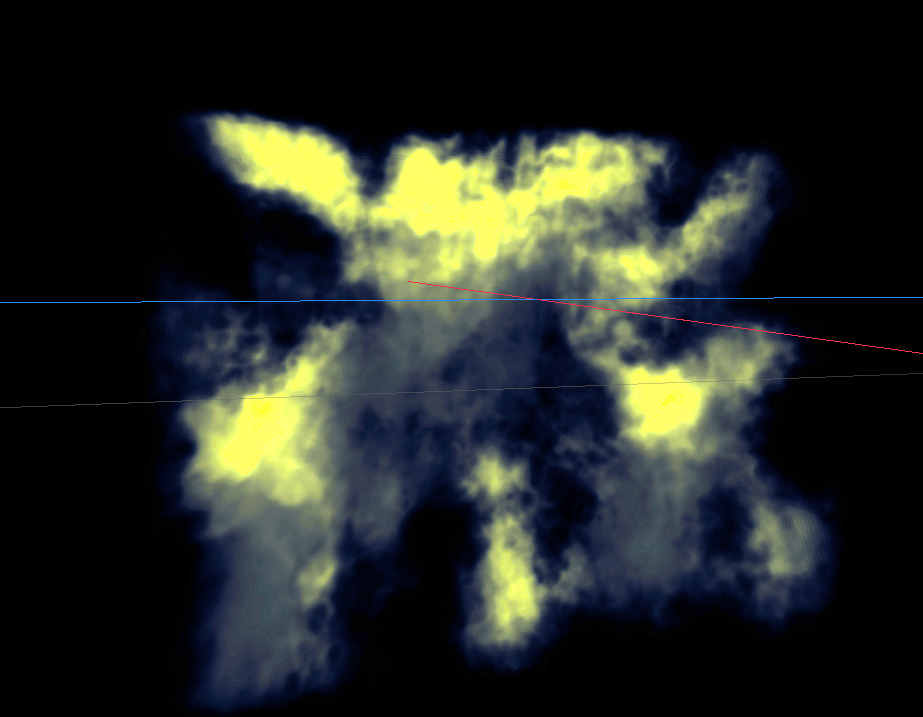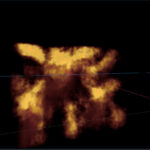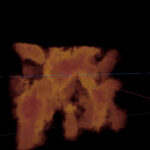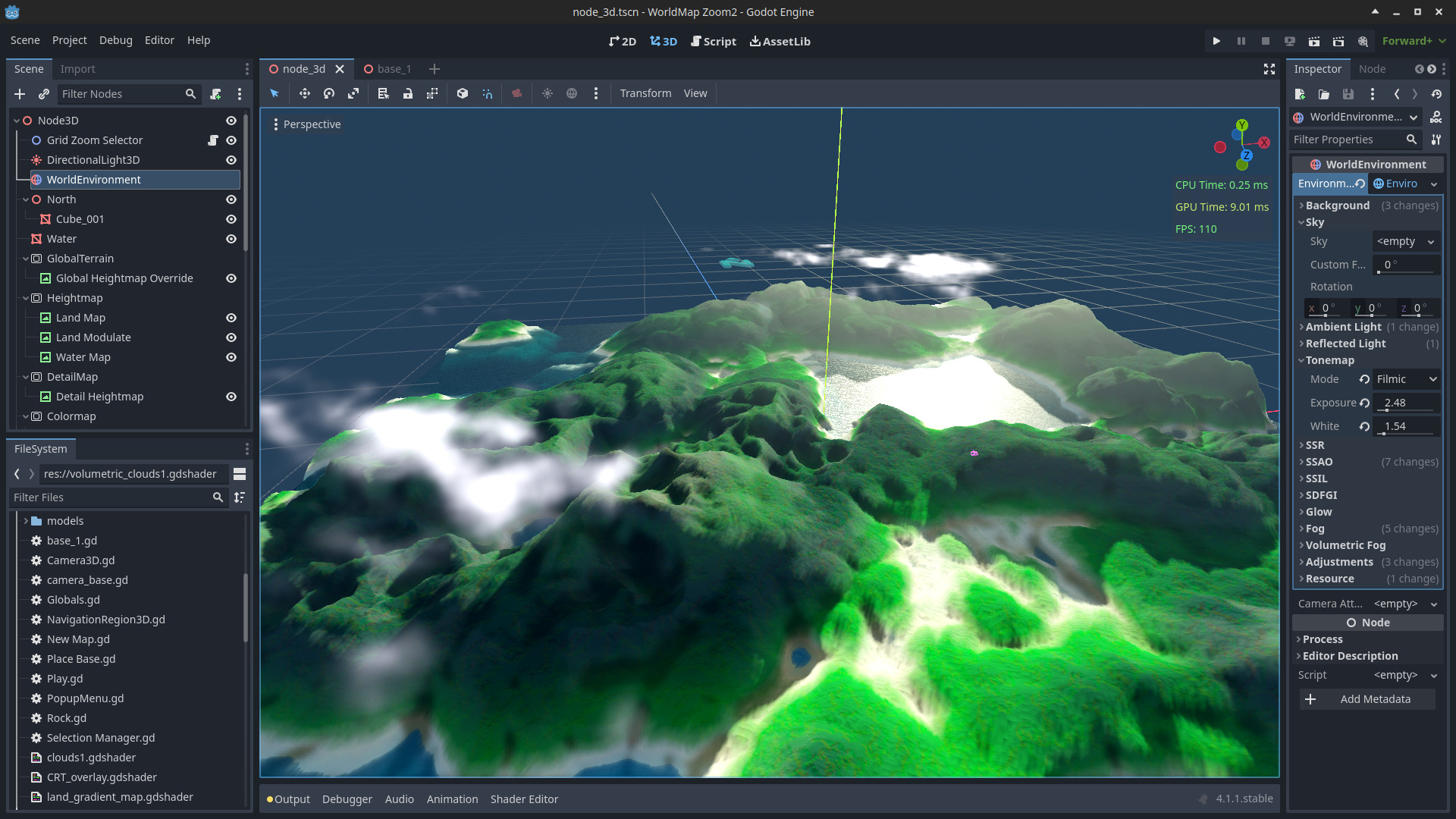Volumetric nebulae/clouds
This shader uses volumetric raymarching for rendering nebulae or clouds.
Also its has still some issues and is not “production ready”. It’s rather a starting point or inspiration for your own shader.
You can find more info in the GitHub repository.
Shader code
shader_type spatial;
render_mode unshaded;
render_mode cull_back;
render_mode depth_draw_never;
#define USE_PERFORMANCE_MODE
#define USE_BOX_BORDER
//#define RENDER_REVERSE
uniform float _totalBrightness;
uniform int _maxSteps;
uniform float _stepSize;
uniform vec3 _rdRotation;
uniform vec3 _lightDir;
uniform float _maxLightDistance;
uniform float _transmissionThreshhold;
uniform float _lightStepSize;
uniform float _lightDensityScale;
uniform int _maxLightSteps;
uniform vec3 _volumeOffset;
uniform vec3 _volumeRotation;
uniform vec3 _volumeScale;
uniform float _densityScale;
uniform float _darknessThreshhold;
uniform float _transmittance;
uniform float _lightAbsorb;
uniform float _epsilon;
uniform sampler2D _gradientTex;
uniform vec4 _gradientTex_ST;
uniform sampler3D _volumeTex;
varying vec3 ro;
varying vec3 hitPos;
varying vec3 normal;
varying vec3 worldSpaceCameraPos;
mat2 rot(float angle){
float s = sin(angle);
float c = cos(angle);
return mat2(vec2(c, -s), vec2(s, c));
}
void rotateX(inout vec3 p, float angle){
p.xy = p.xy * rot(angle);
}
void rotateY(inout vec3 p, float angle){
p.xz = p.xz * rot(angle);
}
void rotateZ(inout vec3 p, float angle){
p.yz = p.yz * rot(angle);
}
void rotate(inout vec3 p, vec3 euler){
rotateX(p, euler.x);
rotateY(p, euler.y);
rotateZ(p, euler.z);
}
float getScene(vec3 p){
p /= _volumeScale;
rotate(p, radians(_volumeRotation));
p += 0.5;
return texture(_volumeTex, p + _volumeOffset).r;
}
bool outOfBounds(vec3 currentPos) {
#if defined(USE_BOX_BORDER)
return (max(abs(currentPos.x), max(abs(currentPos.y), abs(currentPos.z))) > 0.5f + _epsilon);
#else
return false;
#endif
}
bool outOfBoundsLight(vec3 lightPos) {
#if defined(USE_BOX_BORDER)
return (max(abs(lightPos.x), max(abs(lightPos.y), abs(lightPos.z))) > 0.5f + _maxLightDistance);
#else
return false;
#endif
}
vec4 raymarch(vec3 rayOrigin, vec3 rayDirection) {
float density = 0.;
float transmission = 0.;
float lightAccumulation = 0.;
float finalLight = 0.;
vec3 lightingResult = vec3(0);
float transmittance = _transmittance;
vec3 marchVector = rayDirection * _stepSize;
vec3 lightVector = -normalize(_lightDir) * _lightStepSize;
vec3 currentPos = rayOrigin.xyz;
float densityFactor = _densityScale * 0.001;
for (int i = 0; i < _maxSteps; i++) {
currentPos += marchVector;
if (outOfBounds(currentPos)) continue;
float sampledDensity = getScene(currentPos);
density += sampledDensity * densityFactor;
#if defined(USE_PERFORMANCE_MODE)
lightAccumulation += sampledDensity * _lightDensityScale;
#else
vec3 lightRo = currentPos;
for(int j = 0; j < _maxLightSteps; j++){
lightRo += lightVector;
if(transmittance < _transmissionThreshhold || outOfBoundsLight(lightRo)) break;
float lightDensity = getScene(lightRo);
lightAccumulation += lightDensity * _lightDensityScale;
}
#endif
float lightTransmission = exp(-lightAccumulation);
float shadow = _darknessThreshhold + lightTransmission * (1.0 - _darknessThreshhold);
finalLight += density * transmittance * shadow;
transmittance *= exp(-density * _lightAbsorb);
}
transmission = exp(-density);
lightingResult = vec3(finalLight, transmission, transmittance);
vec2 uv = vec2(finalLight * 2., finalLight) * _gradientTex_ST.xy + _gradientTex_ST.zw;
uv.x = mix(0., uv.x, transmission);
uv.y = mix(0., uv.y, transmission);
vec4 gradientColor = texture(_gradientTex, uv);
vec4 resultColor = gradientColor * finalLight;
resultColor.a = (1. - transmittance);
return resultColor;
}
void vertex() {
hitPos = VERTEX;
ro = (inverse(MODELVIEW_MATRIX) * vec4(0, 0, 0, 1)).xyz;
worldSpaceCameraPos = CAMERA_POSITION_WORLD;
}
void fragment() {
#if defined(RENDER_REVERSE)
vec3 _ro = ro;
vec3 rd = normalize(hitPos - ro.xyz);
_ro += rd * _stepSize * float(_maxSteps);
rd = - rd;
vec4 col = raymarch(_ro, rd);
#else
vec3 rd = normalize(hitPos - ro.xyz);
vec4 col = raymarch(ro, rd);
#endif
ALBEDO.xyz = clamp(col.xyz * _totalBrightness, 0., 1.) ;
ALPHA = col.w;
}








Nice, thanks for sharing!